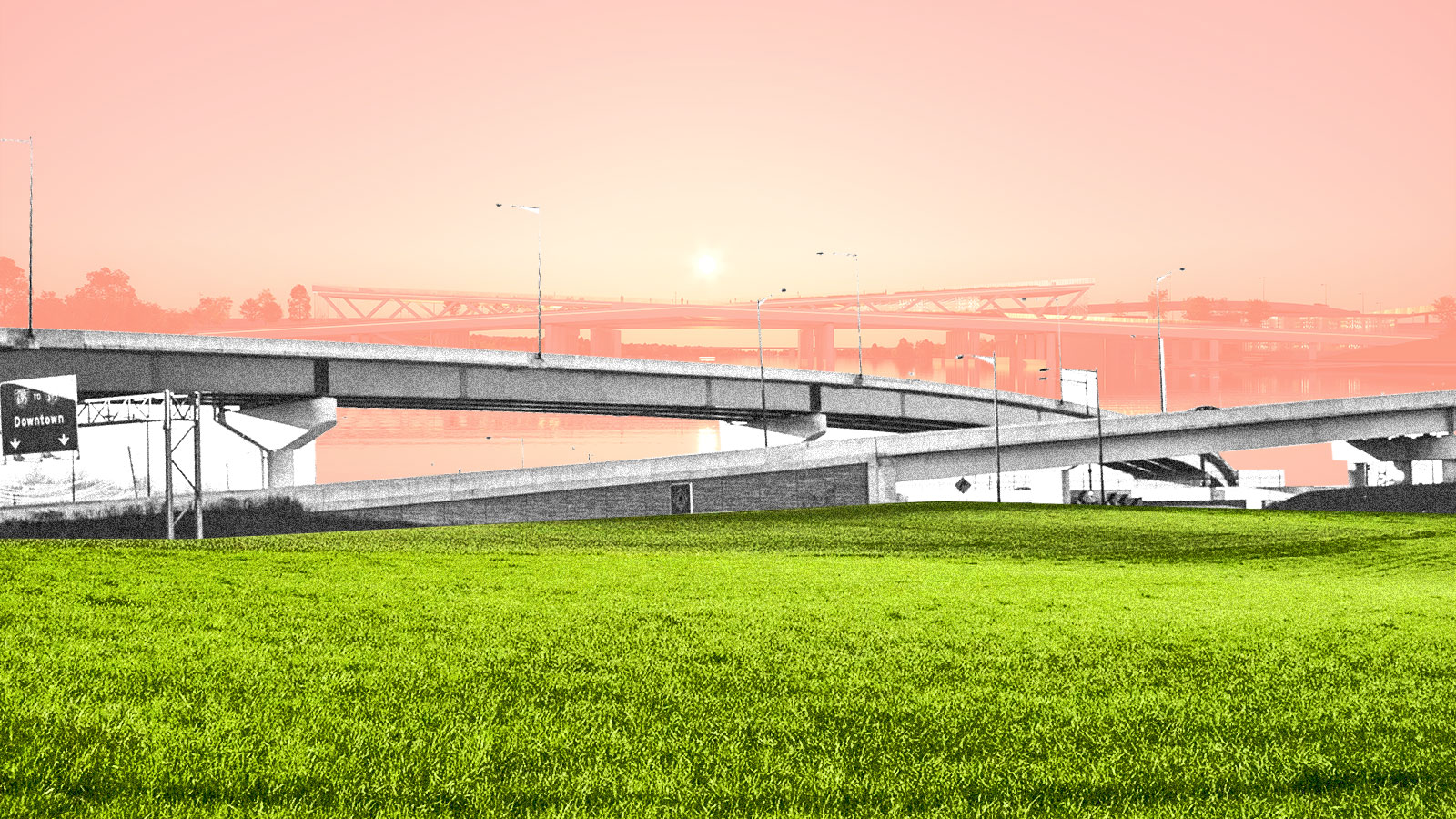It was a gray Tuesday morning in February, a few weeks before the COVID outbreak was declared a global pandemic. The Anacostia River was quiet and serene, except for the sound of raindrops and the low roar of Jim Foster’s boat. Foster, president of the nonprofit Anacostia Watershed Society, was preparing to make his weekly rounds surveying the once-polluted river.
The river, located just five miles south of the White House, separates two very different communities: On the west side of the river sits the Washington Navy Yard, U.S. government buildings, upscale cafes, and luxury apartments. East of the river is the historic Anacostia neighborhood, a predominantly Black community that experiences some of the city’s highest unemployment and poverty rates.
“A lot is changing,” said Foster. He has been rehabilitating the river for more than a decade. Years ago, he used to advise people against visiting the river because of toxic pollution collecting in its waters. Today, Foster wants to bring them closer, now that the river is safer and cleaner. “This is going to be a game-changer,” he said, pointing to the 11th Street Bridge, where cars and trucks thundered above.
This bridge, which connects Capitol Hill to the historic Anacostia neighborhood, will be transformed into an elevated urban park by 2023. The 11th Street Bridge Park will offer a slew of amenities, including an environmental education center, outdoor performance spaces, playgrounds, and community gardens.
“Imagine coming up the river, and there being this iconic structure on the bridge park. Then, at night, it’s lit up,” Foster said while navigating his boat. “I tell people it’s going to be the Arc de Triomphe of the Anacostia restoration. Overall, it’s going to be an incredible structure that will get us a connection not only between the communities east and west of the river, but also a connection to the river itself.”
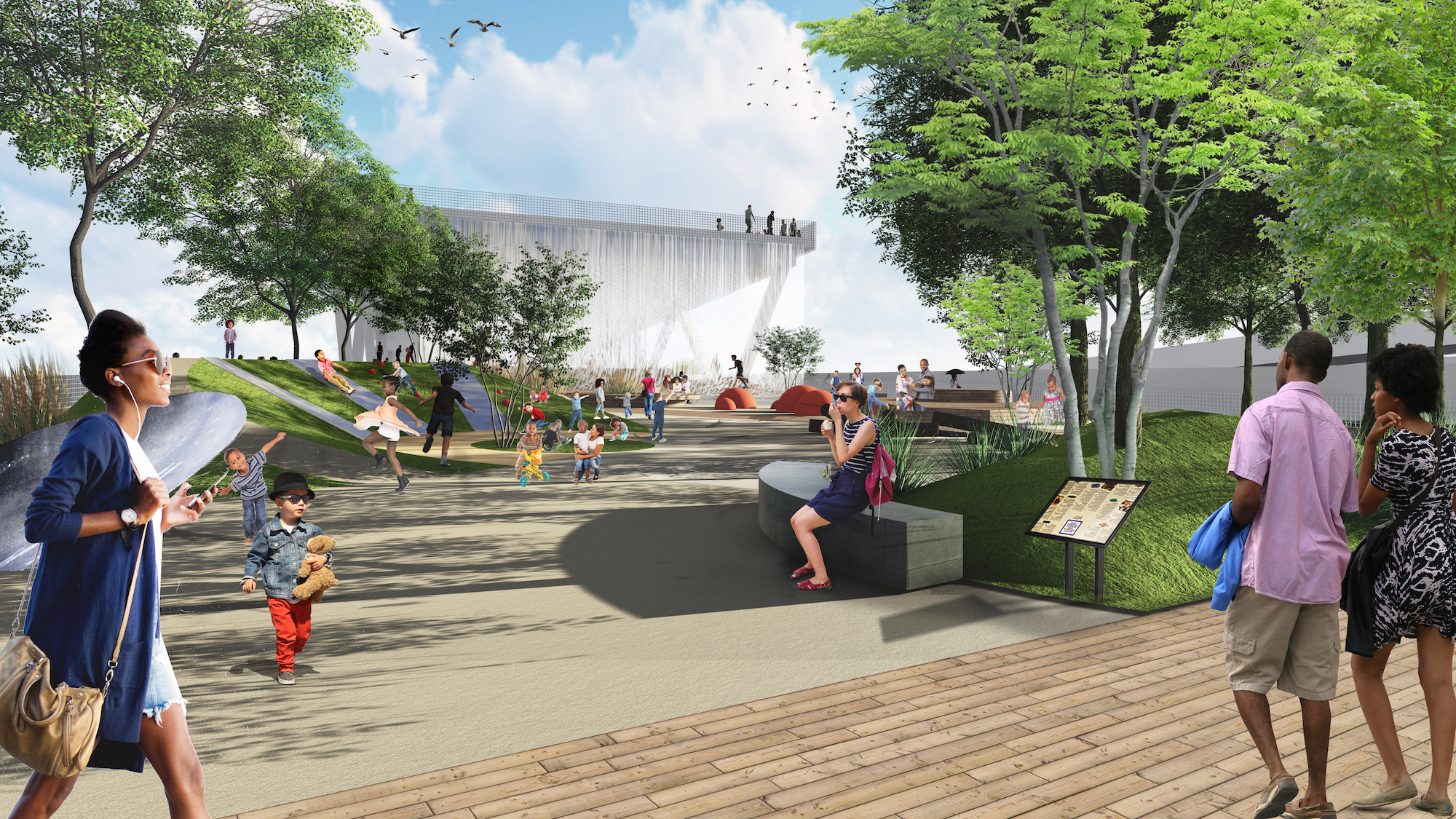
A design mock-up imagines a pedestrian scene at the future 11th Street Bridge Park. OMA New York
Green spaces like the 11th Street Bridge Park are now considered critical urban infrastructure — especially due to the fact that they can help keep a city’s residents cool during sweltering summer heat waves, like the one Washington is currently suffering through. For years, researchers have concluded that the presence of green spaces, parks, and trees in cities can have a positive impact on a person’s mental health and well-being. A study published last year even found that green spaces in urban areas could also prevent premature deaths.
But studies have also shown that city green spaces are more abundant in wealthier and majority-white neighborhoods, while low-income people of color are more likely to live in neighborhoods that experience more extreme urban heat than other parts of their cities, due to a preponderance of heat-absorbing urban design features and a dearth of cooling green space. Washington’s Anacostia neighborhood is one of these hotspots. According to the District of Columbia’s heat vulnerability index map, Anacostia residents face a higher risk of heat stroke and other heat-related illnesses due to a lack of vegetation and tree cover, compared to their wealthier counterparts across the river.
Vivek Shandas, a professor of climate adaptation at Portland State University, said that marginalized communities disproportionately suffer the wrath of heat waves due to a lack of tree canopy and access to well-maintained and safe public green spaces. Some of that disparity, he said, is a legacy of redlining, the government-sanctioned practice of segregating communities of color by denying them housing loans and insurance. Early this year, Shandas co-authored a study that found that redlining was a major predictor of which neighborhoods suffer the most from extreme heat.
“Intentional investment in parks, trees, and transportation access,” Shandas added, was generally “meant for wealthier white neighborhoods.”
As the urban cores of many U.S. cities undergo gentrification, municipal planners have shown a growing interest in turning aging infrastructure, like Washington’s 11th Street Bridge, into major green spaces. But similar projects across the country, such as New York City’s famous High Line and Atlanta’s BeltLine railway, have come under fire for pricing out and displacing longtime residents, especially low-income people of color. Shandas and other urban researchers say that the development of these new urban green spaces contributes to a phenomenon called “green gentrification,” where housing prices spike and an influx of new, wealthier, and largely white residents move into a historically marginalized neighborhood. Displaced residents may be forced into peripheral areas that do not enjoy the amenities now on offer in their former neighborhoods.
“Low-income communities of color may have access to parks, but they tend to be smaller, more crowded, and of lower quality than the parks that are in more affluent and whiter communities,” said Alessandro Rigolon, assistant professor for city and metropolitan planning at the University of Utah.
Rigolon co-authored a policy report that found that implementing parks-related anti-displacement strategies during major urban improvement projects could significantly mitigate green gentrification and overall displacement. These strategies focus on enabling rent control and anti-eviction policies for renters, as well as property tax freezes and down payment assistance for homeowners. They also prioritize local businesses and employment for residents.
The fear of displacement and gentrification is what led many longtime residents east of the Anacostia River, in a community called Ward 8, to initially oppose the 11th Street Bridge Park project. But project leaders saw this growing opposition and decided to set aside design and construction plans while they spent years listening to the community’s concerns — and then putting those concerns at the center of the planning process to brainstorm solutions. The project has been in the making for nearly a decade now.
“We didn’t have a designer involved, no engineers, nothing at that point,” said Irfana Noorani, the deputy director for Building Bridges Across the River (BBAR), the Washington D.C.-based nonprofit that masterminded the 11th Street Bridge Park project. “We were just talking to the community about their interest in having a space like the 11th Street Bridge Park, and whether it’s a good idea and if we should explore it.”
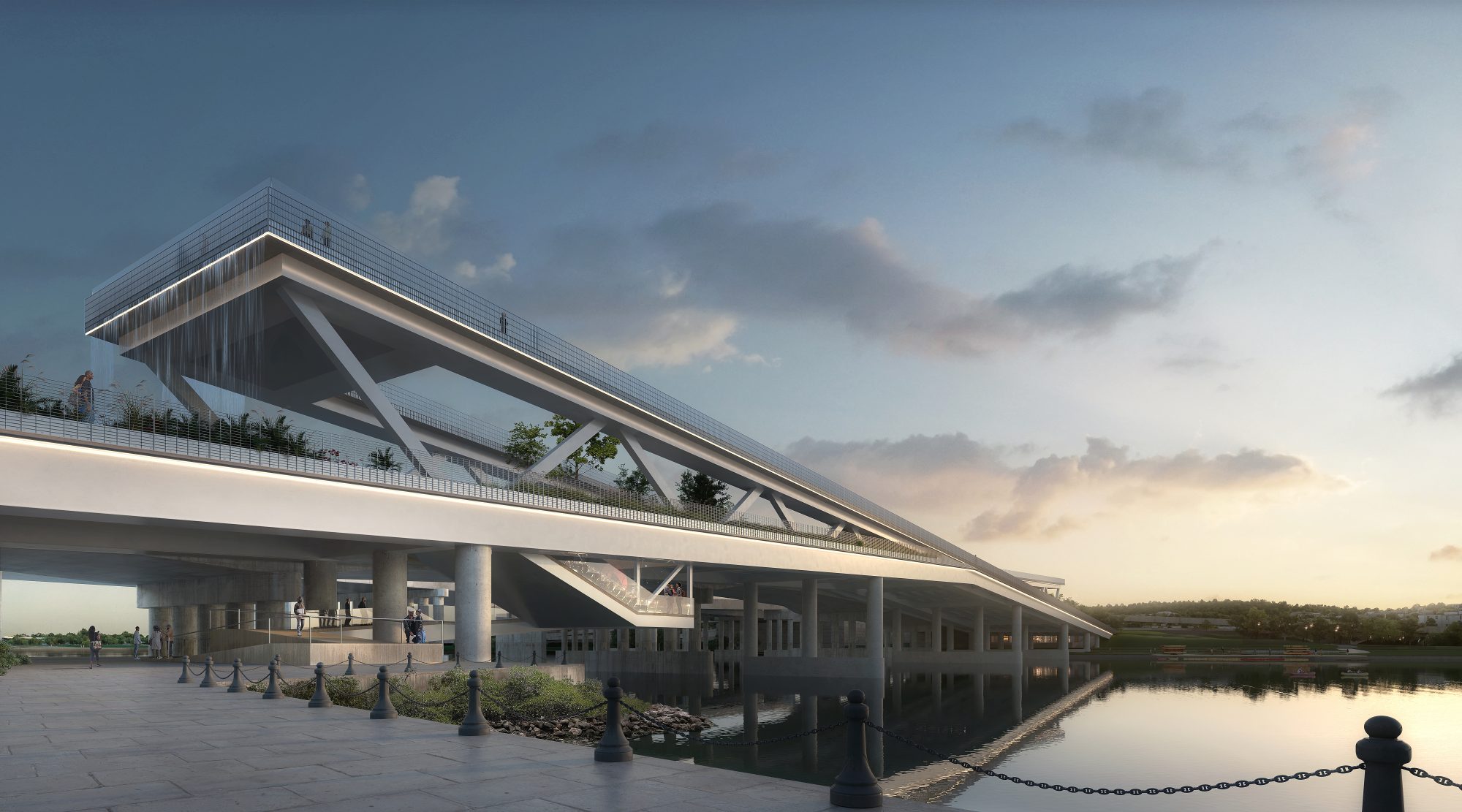
A design of the 11th Street Bridge, connecting Anacostia to Capitol Hill. OMA New York
Brenda Richardson, a longtime Ward 8 resident and activist, was one of the original naysayers. The Ward 8 community was “vehemently opposed in the beginning,” she said. Ward 8 residents — many of whom have experienced homelessness, incarceration, and unemployment — were worried that they would be displaced from their homes by luxury buildings and white-owned businesses. When BBAR became aware of the community’s concerns, they began holding a series of public meetings to hear them out. They also looked at how similar projects impacted other cities.
“We’re looking at the data coming from similar parks across the country, in terms of their impact on the economic pieces, and we know that housing prices tend to rise,” Noorani told Grist. “The data tells us that there will be displacement unless we intentionally make sure that there’s equity and inclusivity in these types of projects.”
Richardson and the rest of the Ward 8 community demanded that BBAR come up with a way to ensure that the project is accompanied by job opportunities, permanent affordable housing, and small business investment. They also wanted to preserve the cultural contributions of the historic Anacostia neighborhood. After years of gathering the community’s input and talking to experts, BBAR established a robust equitable development plan to address the issues highlighted by the community. This eventually caused Richardson to withdraw her opposition to the project. Many of her neighbors did the same.
“When you look at the social issues around the river, the fact of the matter is that those of us who lived here for a long time have been traumatized by the poverty and the violence that we have been compelled to live in,” Richardson told Grist. “And when you are trying to transform a community, you can’t do that by yourself. The 11th Street Bridge Park project is on to something because they paid attention to the community.”
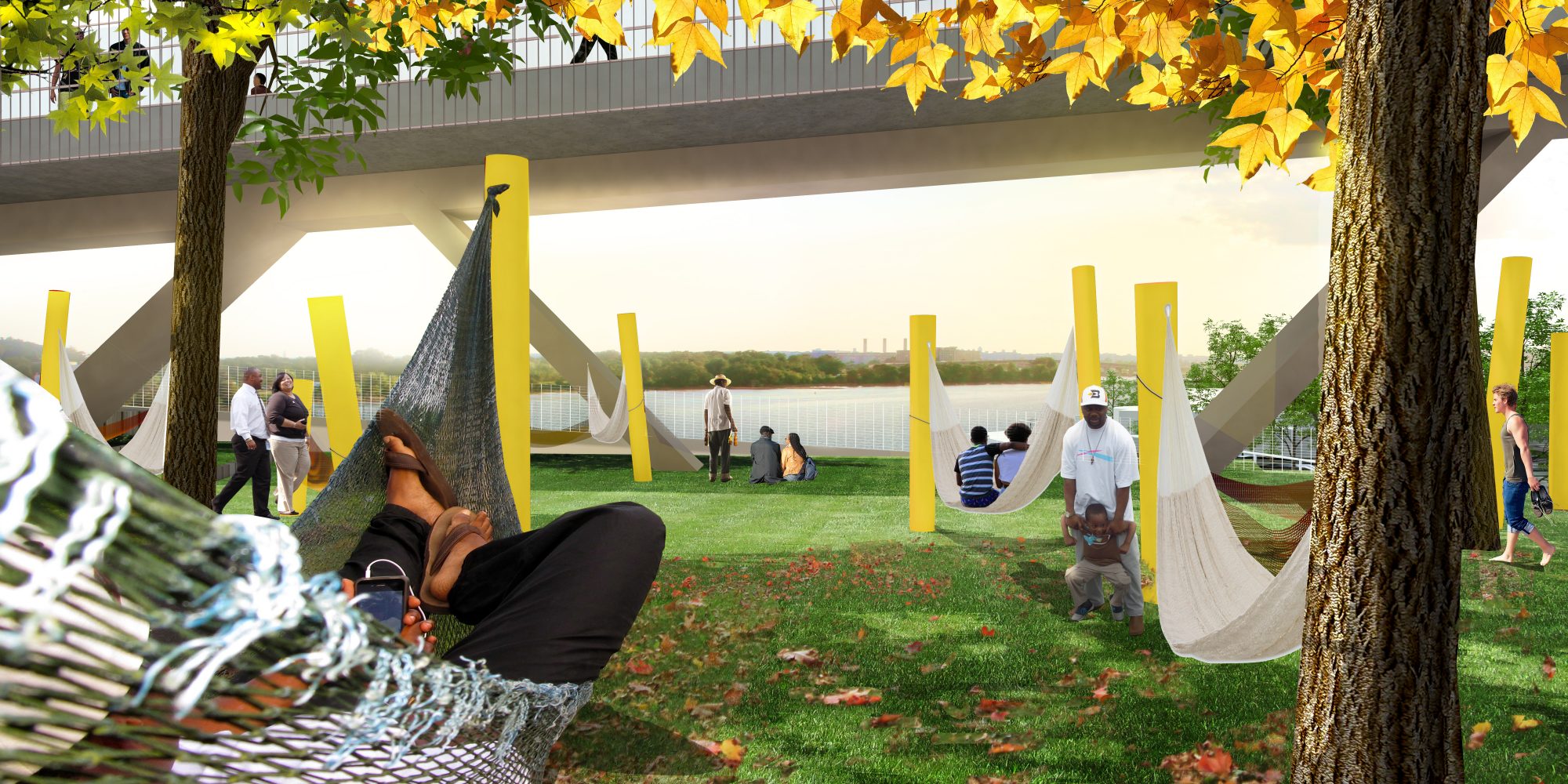
Visitors will be able to lounge in a hammock grove at the future 11th Street Bridge Park. OMA New York
The legacy of housing segregation has proved traumatic for Washington’s Black community, particularly east of the Anacostia. Historical archives show that Black residents were once banned from owning land in the neighborhood, and data collected by BBAR shows that only one-third of Ward 8 residents are homeowners today, which could put them at greater risk of displacement.
BBAR’s equitable development plan strives to ensure that residents east of the river can continue to afford living in their neighborhood once the park is constructed. The organization partnered with city agencies and nonprofits to expand resources by securing philanthropic funding for down payment assistance programs, establishing a Ward 8 home buyers club, and building and preserving affordable housing through a community land trust. The Douglass Community Land Trust, named after abolitionist and onetime Anacostia resident Frederick Douglass, is buying up property in the neighborhood to shield longtime residents from development pressure. The nonprofit has already acquired an apartment complex in Ward 8.
“I’m a strong believer in keeping public land in public hand,” Richardson told Grist. “D.C. is sort of like a divided city — and the 11th Street Bridge Park will be the connector.”
Ward 8 has also suffered the highest unemployment rate in all of Washington, D.C.: Roughly 16 percent of residents living east of the river are unemployed. As a result, Noorani told Grist that a major priority of their equitable development plan is hiring residents who face structural challenges to securing employment — especially youth and formerly incarcerated people — for construction and post-construction job opportunities at the 11th Street Bridge Park. The project is also supporting workforce training programs.
“You can’t change communities in a year or two. It takes years to do that and have people trust that you do right by them,” Richardson told Grist. “The 11th Street Bridge Park folks listened and discovered that having a sense of equity was a priority, so they have gained the community’s trust in a very big way.”
If it works out as planned, the 11th Street Bridge Park may turn out to be a model for future urban green space development projects. But there are other, smaller community-led organizations across the country that are working to redevelop and repair formerly marginalized neighborhoods that have yet to receive robust investment, including for urban green spaces.
Green scenes in the Rose City
In the 1960s, the Oregon State Highway Department used eminent domain to bulldoze through the heart of the Albina neighborhood in Portland to build the Interstate 5 freeway, demolishing more than 300 homes in the process. The construction, part of a nationwide approach to urban renewal, led to a massive decline in what was once Portland’s thriving Black community.
Rukaiyah Adams, 46, grew up in the Albina neighborhood. After leaving home to attend Stanford Law School and work on Wall Street, she ultimately decided to come back to her hometown and give back to the community she grew up in.
She’s noticed that a different sort of change has come to the neighborhood in recent years: Community investment has improved since white residents started moving in, and playgrounds in urban parks have become safer and well-maintained.
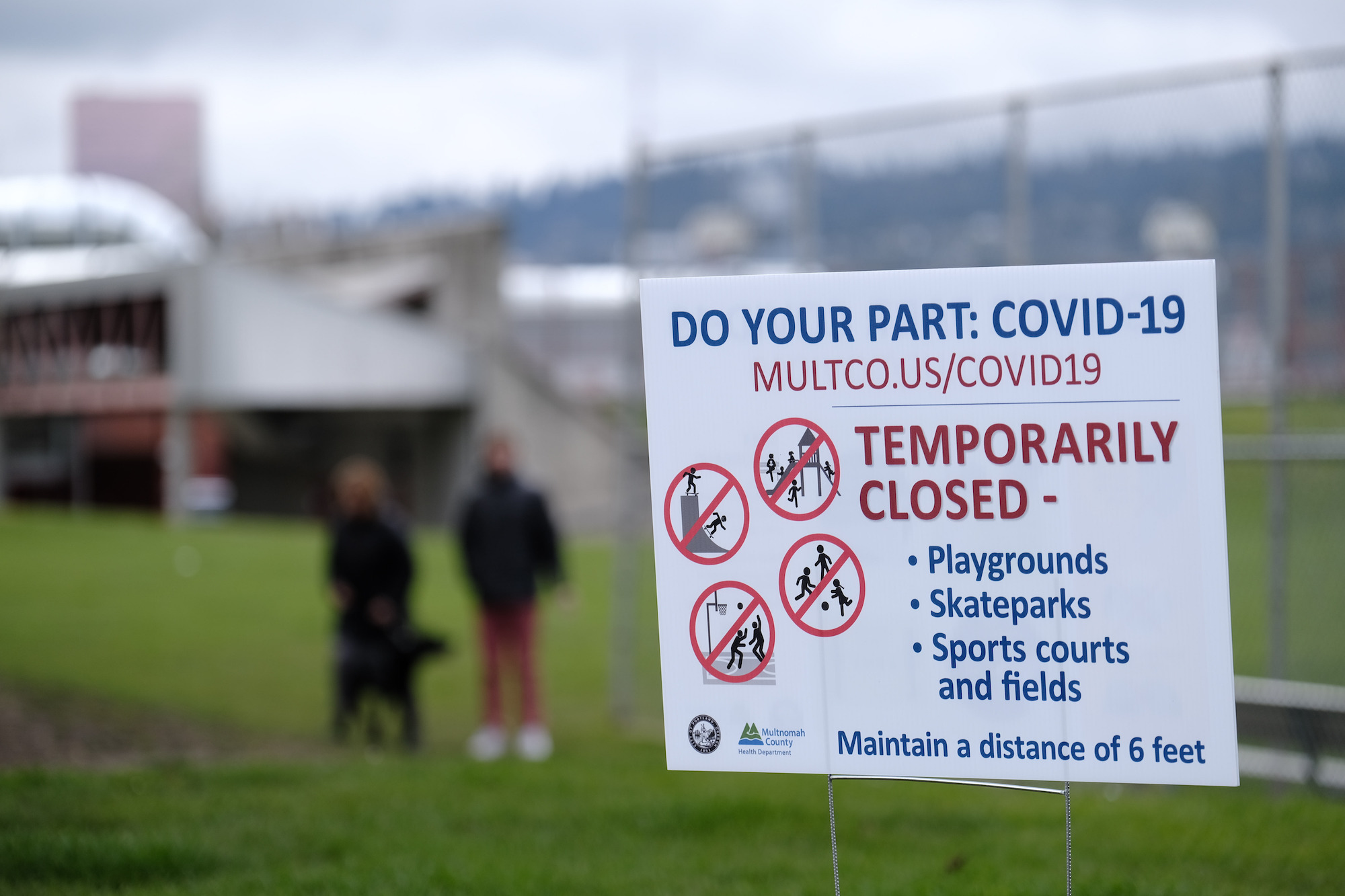
People walk their dog in Lillis Albina Park in Portland during the COVID-19 pandemic. Alex Milan Tracy / Anadolu Agency via Getty Images
Adams chairs a nonprofit called Albina Vision, a group that’s working to repair the damage done to the Black community in the Albina neighborhood. She believes that change starts with an equitable urban growth and design plan that centers on racial and environmental justice.
“Reparation is not transactional, it’s not a single cash transaction,” Adams told Grist. “It’s a fundamental change in the way that we design and share the urban form.”
According to Shandas’ study on redlining and urban heat, the greatest temperature disparities between redlined and non-redlined neighborhoods in the U.S. — differences of up to 12.6 degrees F — are in Portland. Racist policy decisions and a lack of community investment widened these disparities. Portland city officials have a history of investing more on safe green spaces built in wealthier neighborhoods. Researchers like Shandas and Rigolon maintain that this contributes to a cycle of systemic inequities. Without green spaces to cool a neighborhood, low-income communities may face more substantial financial burdens, due in part to greater energy consumption from air conditioning as well as medical bills from conditions caused or exacerbated by severe heat.
Adams said that Albina Vision is working to redevelop the 94 acres of land that the neighborhood lost decades ago. She considers the project a form of reparation that transforms the way that residents live. The group proposes to both build affordable housing and push for large-scale urban green spaces to cool the city. And just like BBAR, Albina Vision wants to create a strong public connection to the Willamette River, which separates the Albina neighborhood from downtown Portland.
“With Albina Vision, we’re thinking about how we design parks to accommodate dense, affordable housing and redesign street-level experience to create parks and green spaces,” Adams said.
With renewed calls for racial justice across the country, Adams said that addressing environmental injustice through community investment is crucial. Whether it means building a large-scale project like the 11th Street Bridge Park or a smaller-scale open green space as part of a community redevelopment plan, environmental justice solutions start with including those who haven’t historically had a say in the planning process.
“Because we were so intentional in destroying Black communities,” Adams added, “we must also be intentional in rebuilding them.”
